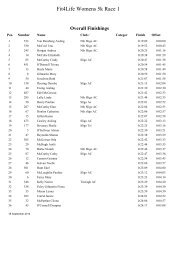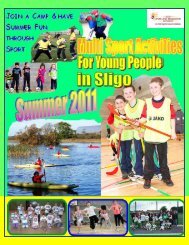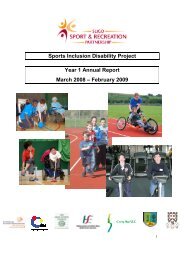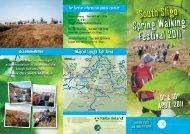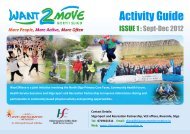Girls Active Programme - Sligo Sport and Recreation Partnership
Girls Active Programme - Sligo Sport and Recreation Partnership
Girls Active Programme - Sligo Sport and Recreation Partnership
You also want an ePaper? Increase the reach of your titles
YUMPU automatically turns print PDFs into web optimized ePapers that Google loves.
Findings<br />
teacher appointed for the initiative was also the<br />
SPHE co-ordinator <strong>and</strong> felt “happy to take it on”<br />
as she recognised that there was a link between<br />
both programmes. Also, she commented that she<br />
was physically unfit herself <strong>and</strong> so the participating<br />
girls were likely to feel that she would have more<br />
of an underst<strong>and</strong>ing of the non-sporty psyche. She<br />
described the principal as being “100% behind the<br />
programme”.<br />
All 20 of the 3rd years (Junior Cert year, 14-<br />
15yr olds) that were not involved in sport either<br />
inside or outside of school were recruited onto<br />
the programme <strong>and</strong> attendance was made<br />
compulsory 20 . This particular class group was<br />
chosen to participate because younger students<br />
“will be involved anyway”, <strong>and</strong> the principal hoped<br />
that participation by this year class might encourage<br />
them to continue to be physically active through<br />
the senior cycle. Sessions were held in the school<br />
gym during lunchtime <strong>and</strong> the activities undertaken<br />
were aerobics, tai chi <strong>and</strong> yoga. The girls were not<br />
charged a fee to take part in <strong>Girls</strong> <strong>Active</strong>. Instead,<br />
additional costs were paid from an ‘activity fee’ that<br />
each school student pays annually to cover the costs<br />
of buses <strong>and</strong> other extra-curricular expenses.<br />
The school also participated in the programme<br />
in Phase Three (2005/6). Sessions were again<br />
held at lunchtime, the activities changed slightly to<br />
aerobics, circuit training <strong>and</strong> dance <strong>and</strong> non-sporty<br />
2nd years were permitted to join in with the then<br />
current 3rd years. The girls who participated in<br />
2004/5 were no longer permitted to be involved.<br />
Attitudes to physical activity. The girls in School<br />
A expressed an alienation from the traditional<br />
concept of sport <strong>and</strong> compared it unfavourably to<br />
<strong>Girls</strong> <strong>Active</strong> activities:<br />
“Aerobics is more of a hobby or a pastime. You feel<br />
better after you do it. <strong>Sport</strong> is about winning, this is<br />
an exercise”<br />
“There were no captains or teams or games away<br />
that would put pressure on you [in <strong>Girls</strong> <strong>Active</strong>] ...<br />
that would have put me off it”<br />
“[<strong>Girls</strong> <strong>Active</strong>] was different to what everyone else<br />
does [for sport]. It wasn’t the normal routine of<br />
sport”<br />
The school principal was aware that many young<br />
people felt like this:<br />
“Competition puts [some] kids off. <strong>Girls</strong> <strong>Active</strong><br />
[activities] aren’t competitive”<br />
Timing of activities. One <strong>Girls</strong> <strong>Active</strong> activity took<br />
place before Christmas <strong>and</strong> two after Christmas.<br />
The co-ordinator expressed concerns about<br />
sessions running up to exams late in the year. All of<br />
the activities were organised during lunchtime with<br />
some time off the class beforeh<strong>and</strong> to allow girls<br />
time to have lunch 21 . The girls in this school said<br />
that the fact that they were not rushed was one of<br />
the best things about <strong>Girls</strong> <strong>Active</strong> for them.<br />
“We had the last class off so we could go up town<br />
<strong>and</strong> have lunch at our ease”<br />
However, in Phase Three this position changed<br />
<strong>and</strong> the girls then had to do the activity within lunch<br />
break as regular time off class caused complications<br />
for other teachers. The co-ordinator highlighted the<br />
lack of available time as one of the disadvantages<br />
of the programme since “lunch hour is only 50min.<br />
<strong>and</strong> is not long enough, the girls have to eat on the<br />
run”. She also commented that there would be less<br />
girls taking part if sessions were switched to after<br />
school time due to the fact that they have to catch<br />
buses home.<br />
Attendance at sessions. Attendance at the<br />
sessions was generally good, not surprising given<br />
that <strong>Girls</strong> <strong>Active</strong> sessions were made compulsory<br />
for the participating girls. However, the principal<br />
stated that “there were no sick notes”, <strong>and</strong> the girls<br />
indicated why this was so:<br />
“It was m<strong>and</strong>atory for us but it was good. It was fun<br />
<strong>and</strong> we enjoyed it”<br />
However, one girl indicated that some flexibility was<br />
allowed in terms of attendance:<br />
16<br />
Evaluation of the <strong>Girls</strong> <strong>Active</strong> <strong>Programme</strong> - 2003 – 2005 Report



